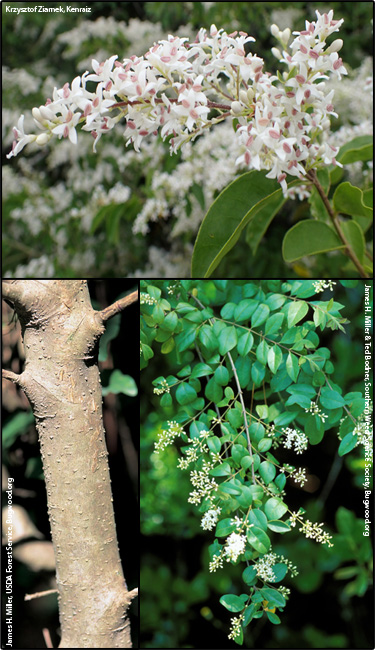Chinese privet (Ligustrum sinense)
 Synonyms: Ligustrum microcarpum, Ligustrum villosum
Synonyms: Ligustrum microcarpum, Ligustrum villosumCommon Names: Common chinese privet, common privet
Description: Introduced to the United States in 1852 for ornamental uses. Commonly used for hedgerows and the fruit is toxic to humans.
Habit: Semi-evergreen shrub or small tree growing to about 20 ft. (6.1 m) in height.
Leaves: Opposite, oblong, 1-2.4 in (2.5-6 cm) long and 0.2-0.6 in (0.5-1.5 cm) wide. Pubescent along the underside of midvein.
Stems: Multiple and having tiny hairs.
Flowers: Panicles of white to cream flowers in terminal and upper axillary clusters.
Fruit and seeds: Spherical, 0.3-0.5 in. (1-1.3 cm) long. Starts green in color but ripens to dark purple or black. Persists into winter. Soil viability is about one year.
Habitat: Native to Europe and Asia. Can be found in fields, fencerows, roadsides, forest understories and riparian sites.
Reproduction: By seed and vegetatively by root sprouts.
Monitoring and rapid response: Remove individual plants before flowering. Plants with stems less than one inch in diameter can be handpulled along with all roots to prevent resprouting. Mowing and cutting is not recommended. Glyphosate can be used on larger infestations when applied to foliage in late fall. Credits: The information provided in this factsheet was gathered from the Invasive Plant Atlas of the United States and the Lewis Ginter Botanical Garden.
Individual species images that appear with a number in a black box are courtesy of the Bugwood.org network (http://www.invasive.org). Individual photo author credits may not be included due to the small display size of the images and subsequent difficulty of reading the provided text. All other images appear courtesy of Google (http://images.google.com).
